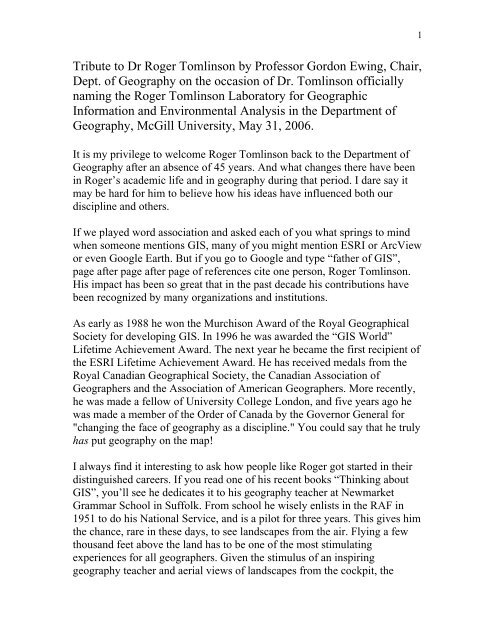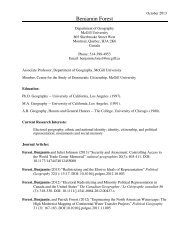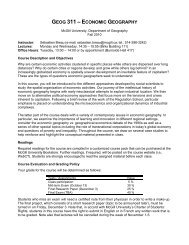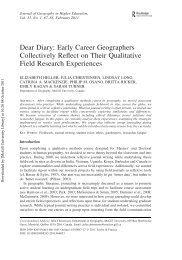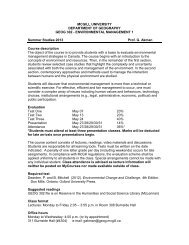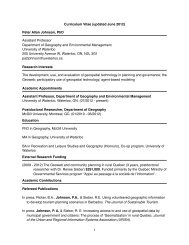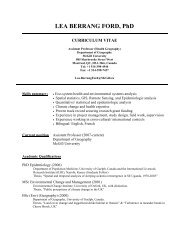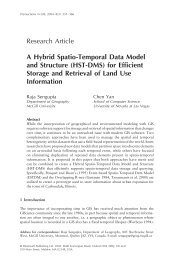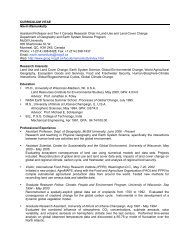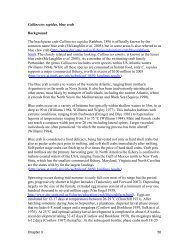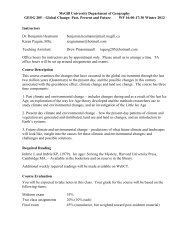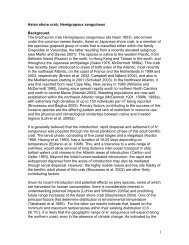Tribute to Roger Tomlinson - Department of Geography, McGill ...
Tribute to Roger Tomlinson - Department of Geography, McGill ...
Tribute to Roger Tomlinson - Department of Geography, McGill ...
Create successful ePaper yourself
Turn your PDF publications into a flip-book with our unique Google optimized e-Paper software.
1<strong>Tribute</strong> <strong>to</strong> Dr <strong>Roger</strong> <strong>Tomlinson</strong> by Pr<strong>of</strong>essor Gordon Ewing, Chair,Dept. <strong>of</strong> <strong>Geography</strong> on the occasion <strong>of</strong> Dr. <strong>Tomlinson</strong> <strong>of</strong>ficiallynaming the <strong>Roger</strong> <strong>Tomlinson</strong> Labora<strong>to</strong>ry for GeographicInformation and Environmental Analysis in the <strong>Department</strong> <strong>of</strong><strong>Geography</strong>, <strong>McGill</strong> University, May 31, 2006.It is my privilege <strong>to</strong> welcome <strong>Roger</strong> <strong>Tomlinson</strong> back <strong>to</strong> the <strong>Department</strong> <strong>of</strong><strong>Geography</strong> after an absence <strong>of</strong> 45 years. And what changes there have beenin <strong>Roger</strong>’s academic life and in geography during that period. I dare say itmay be hard for him <strong>to</strong> believe how his ideas have influenced both ourdiscipline and others.If we played word association and asked each <strong>of</strong> you what springs <strong>to</strong> mindwhen someone mentions GIS, many <strong>of</strong> you might mention ESRI or ArcViewor even Google Earth. But if you go <strong>to</strong> Google and type “father <strong>of</strong> GIS”,page after page after page <strong>of</strong> references cite one person, <strong>Roger</strong> <strong>Tomlinson</strong>.His impact has been so great that in the past decade his contributions havebeen recognized by many organizations and institutions.As early as 1988 he won the Murchison Award <strong>of</strong> the Royal GeographicalSociety for developing GIS. In 1996 he was awarded the “GIS World”Lifetime Achievement Award. The next year he became the first recipient <strong>of</strong>the ESRI Lifetime Achievement Award. He has received medals from theRoyal Canadian Geographical Society, the Canadian Association <strong>of</strong>Geographers and the Association <strong>of</strong> American Geographers. More recently,he was made a fellow <strong>of</strong> University College London, and five years ago hewas made a member <strong>of</strong> the Order <strong>of</strong> Canada by the Governor General for"changing the face <strong>of</strong> geography as a discipline." You could say that he trulyhas put geography on the map!I always find it interesting <strong>to</strong> ask how people like <strong>Roger</strong> got started in theirdistinguished careers. If you read one <strong>of</strong> his recent books “Thinking aboutGIS”, you’ll see he dedicates it <strong>to</strong> his geography teacher at NewmarketGrammar School in Suffolk. From school he wisely enlists in the RAF in1951 <strong>to</strong> do his National Service, and is a pilot for three years. This gives himthe chance, rare in these days, <strong>to</strong> see landscapes from the air. Flying a fewthousand feet above the land has <strong>to</strong> be one <strong>of</strong> the most stimulatingexperiences for all geographers. Given the stimulus <strong>of</strong> an inspiringgeography teacher and aerial views <strong>of</strong> landscapes from the cockpit, the
2natural next step is <strong>to</strong> read geography at university. But, in addition <strong>to</strong> aB.Sc. in geography, he simultaneously studies pho<strong>to</strong>grammetry for a year,and for good measure takes 2 <strong>of</strong> the 3 years <strong>of</strong> the geology degree. So wecan begin <strong>to</strong> see that he is destined <strong>to</strong> do something involving landscapes.Like many Brits at that time, he then comes <strong>to</strong> Canada in 1957 <strong>to</strong> do agraduate degree. He chooses <strong>McGill</strong> and geomorphology, and is supervisedby the man who until his death four years ago was the dean <strong>of</strong> geography inCanada, another expatriate Brit, the illustrious Ken Hare, who himself madea tremendous impression on those he taught and supervised. After <strong>Roger</strong>spends a year at <strong>McGill</strong>’s Sub-Arctic Research Station at Knob Lake(Schefferville) and time in the field in the Kaumajet Mountains in northernLabrador, his pace <strong>of</strong> life becomes more hectic, not least because he’sbecome a father! He simultaneously completes a geology degree at Acadia,becomes an Assistant Pr<strong>of</strong>. in geology there, while having already joined theaerial survey company, Spartan Air Services in Ottawa in 1959. Oh, and inthe meantime, after being suitably prodded by Brian Bird, he completes hisM.Sc. degree in 1961.After four years at Spartan, where he is now head <strong>of</strong> its computer mappingdivision, he moves in 1964 <strong>to</strong> the federal government and leads thedevelopment <strong>of</strong> the Canada Geographic Information System which is born in1967 and used <strong>to</strong> analyse the seven layers <strong>of</strong> environmental data collected bythe Canada Land Inven<strong>to</strong>ry for rural land use planning.So GIS is born in Canada’s Centennial year in the nation’s capital, and thenshowcased in its greatest city at Expo ’67! If this was part <strong>of</strong> a novel, you’dsay it was <strong>to</strong>o far fetched.In 1968 at the ripe old age <strong>of</strong> 34, he becomes chair <strong>of</strong> the IGU Commissionon Geographical Data Sensing and Processing, with older luminaries on thecommittee including the likes <strong>of</strong> Waldo Tobler and David Simonett.Two years later in Oc<strong>to</strong>ber, 1970 in Ottawa he chairs the UNESCO/IGUFirst Symposium on Geographical Information Systems, bringing <strong>to</strong>getherresearchers from Europe, the USA and Canada.In <strong>Roger</strong>’s Summary <strong>of</strong> Proceedings he notes that the terms “geographicinformation systems” and “environment information systems” are usedsynonymously. Here at <strong>McGill</strong> we manage <strong>to</strong> have both a <strong>Department</strong> <strong>of</strong>
3<strong>Geography</strong> and a School <strong>of</strong> Environment. I won’t say any more on that<strong>to</strong>pic! But if you look at the full title <strong>of</strong> this lab, you’ll see it’s the <strong>Roger</strong><strong>Tomlinson</strong> Lab for Geographic Information and Environmental Analysis.Surely this embodies the spirit <strong>of</strong> <strong>Roger</strong>’s remarks in 1970 and the purpose<strong>of</strong> the discipline called geography.In his opening address he tells the assembled delegates that they face aunique situation in that the science <strong>of</strong> geography may have reached a turningpoint because <strong>of</strong> parallel developments in the science <strong>of</strong> data processing.And he goes on <strong>to</strong> say that while all sciences can benefit from thecapabilities <strong>of</strong>fered by data processing, geography with its focus on thewhole surface <strong>of</strong> the globe and the vast array <strong>of</strong> environmental data, can usethese capabilities <strong>to</strong> best advantage. But, he says, “I’m not simply referring<strong>to</strong> the rivers and forests and natural countryside so beloved <strong>of</strong> pollutioncontrol activists. Our environment is the whole living space <strong>of</strong> mankind,with man himself, his creations and his actions as important elements withinit.” Here speaks a true geographer.Since these early days <strong>of</strong> GIS, <strong>Roger</strong> <strong>Tomlinson</strong> has continued <strong>to</strong> be a leaderamong thinkers in the field. But there’s one unusual feature about such aleadership role. We’re used <strong>to</strong> thinking <strong>of</strong> university-based academicsplaying this role. But for the past forty-five years <strong>Roger</strong> has not been auniversity-based academic. He’s been a consultant geographer earning hiskeep from contract projects, which <strong>of</strong>ten narrows horizons and engendersintellectual avoidance <strong>of</strong> big issues. Nothing can be further from the truth in<strong>Roger</strong>’s case. Not only is he the father <strong>of</strong> GIS. He has also stuck around andensured that it grew up <strong>to</strong> be a mature adult!I would now like <strong>to</strong> ask <strong>Roger</strong> <strong>to</strong> <strong>of</strong>ficially name this new lab, but beforedoing so, please join me in saluting <strong>Roger</strong>’s lifetime <strong>of</strong> achievement ingeography and GIS.


